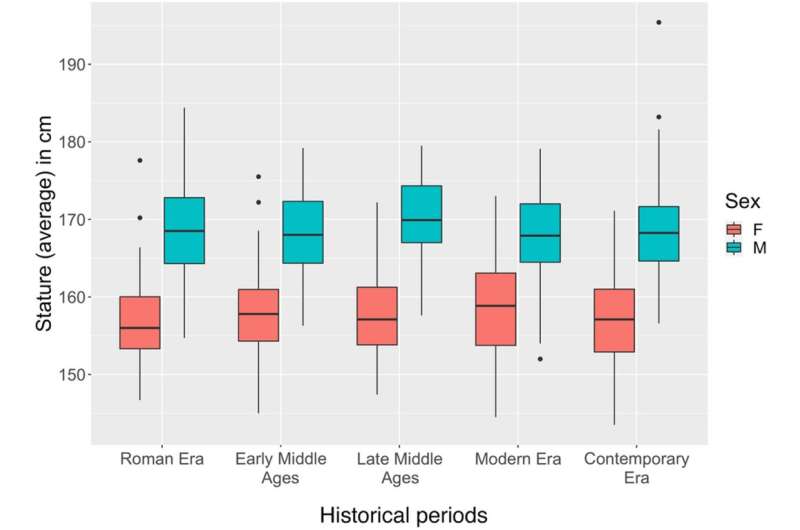Human height remained unchanged for 2,000 years in Milan, finds study

A study covering 2,000 years of male and female adult statures in Milan, Italy, has been published in the journal Scientific Reports, illustrating a stable environmental influence on height.
Human height depends on an interplay between genetics and environmental factors like fetal health, childhood nutrition, disease exposures, as well as environmental epigenetic factors that can reach back generations. While genetics alone may determine how tall a person could become, the environment they are born into plays a significant role in how much of that genetic growth potential is realized.
Typically when we look around the world, we see that as health and nutrition have become more reliable since the industrial revolution, humans have reached increasingly greater heights.
In past studies, population stature has been linked to environmental factors. Human height dramatically reduced during the switch from hunter-gatherers to more agricultural societies. If you used historically accurate stature to make a movie about the Trojan war, you would need to hire male actors under 169 cm (approximately 5'6''). Human height has been slowly increasing since then, occasionally being shown to wax and wane with times of sustained prosperity, wars, famines, climate change, and exposure to plague.
In the study, researchers from the Università degli Studi di Milano, analyzed 549 skeletal remains from 13 different sites, all within Milan. The remains all came from necropolises dedicated to the less wealthy classes of Milanese society. They were assigned to one of five historical periods: Roman Era (first–fifth centuries AD), Early Middle Ages (sixth–tenth centuries AD), Late Middle Ages (eleventh–fifteenth centuries AD), Modern Era (sixteenth–eighteenth centuries AD) and Contemporary Era (nineteenth–twentieth centuries AD).
About 100 individuals were assessed for each era, split between male and female. Stature was estimated, mostly using femur bones, according to a well-established forensic regression formula. Individual female heights ranged from 143.5 to 177.6 cm, with a mean of 157.8 cm (about 5'2''). Males ranged from 152.0 to 195.4 cm, with a mean of 168.5 cm (5'6''). There was no significant change in average heights when comparing the historical periods.
By focusing their study on a single geographic location with similar urban and socioeconomic characteristics, researchers were able to remove biases that might arise in studies of multiple populations with distinct environmental influences. With such a homogenous environment, external forces on population height, like wars, plagues, or climate, should have been obvious.
Surprisingly, there were no significant fluctuations seen in the statures. Suggesting to the study authors that city life in Milan has provided a stable environment for thousands of years, even for its lowest-income inhabitants.
More information: Lucie Biehler-Gomez et al, The diachronic trend of female and male stature in Milan over 2000 years, Scientific Reports (2023). DOI: 10.1038/s41598-023-28406-5
Journal information: Scientific Reports
© 2023 Science X NetworkA study of genetic contributions to changes in prehistoric human stature
No comments:
Post a Comment